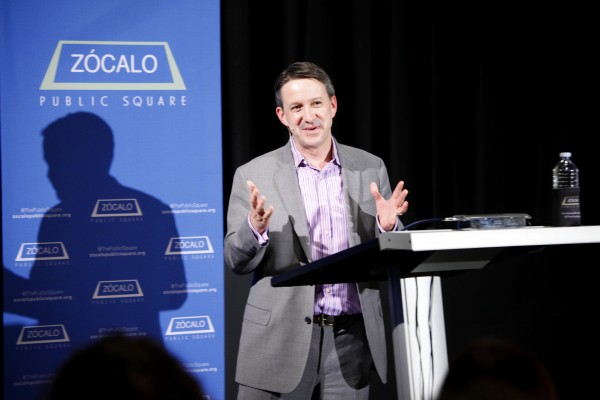Have Universities Failed Millennials? from Zocalo Public Square on Vimeo.
For decades, a college degree “was a signal that people were ready for the workforce,” a sign to parents that their children “were going to be golden in the job market,” said Jeffrey J. Selingo, author of There Is Life After College and former editor of the Chronicle of Higher Education. “That is no longer true,” he said, as he opened a talk for an enthusiastic Zócalo crowd at the Goethe-Institut Los Angeles.
According to the Federal Reserve, almost 50 percent of recent college graduates are underemployed. What’s critical, said Selingo, isn’t only whether young people graduate from college but “how students go to college.”
Over the past few years, Selingo talked with high school and college students, university faculty, parents, high school teachers, recent graduates, and employers of all sizes and kinds. What he found was that there is a deep disconnect between our higher education system and our 21st-century economy.
Employers, said Selingo, are looking for students with “soft skills” like curiosity and creativity, grit and humility. They’re looking for employees who are good at problem-solving, communication, and writing. The head of global learning at Xerox told Selingo that new employees know how to take courses, but they don’t know how to learn.
College has become more structured as workplaces and career paths have become less so. “College is very task-based,” said Selingo. “It has a certain cadence to it.” Students know due dates, vacation periods, course options. In the workplace, by contrast, recent graduates face an unstructured schedule full of “competing priorities and decisions that need to be made on the fly.” The students who get the most out of college, said Selingo, have learned how to navigate life and build relationships outside the classroom.
The most successful millennials, said Selingo, share three markers of success. The first is that they have less undergraduate debt and more flexibility to choose jobs based on their desires and opportunities for career advancement rather than simply for the money.
The second is that they have at least one internship. “Hands-on learning has become so much more critical,” said Selingo. “Increasingly today it is the only pathway into a job.” Some large companies hire 75 percent of new employees through their intern pools.
The third marker is having a college degree; students with some college credit but no degree are far more likely to struggle than those who complete their degrees.
Selingo believes that students, schools, colleges, parents, and employers can all make changes to fix our current system. He offered three ways to help more young people navigate the years after high school successfully:
First, fail fast, fail cheap. “Most students today don’t see good models of failure in high school or college,” said Selingo. They write a paper or do a presentation, get a grade, and move on. At work, we write draft after draft until we get it right, and have to bounce back from failures.
Second, put more students to work, and give them hands-on learning opportunities. The number of teens working a job while in high school has dropped to a historic low. Meanwhile, colleges put a greater emphasis on general education classes that don’t teach students how to apply their theoretical knowledge in practice.
Third, give students more time. Young people are expected to head to college three months after high school graduation, finish college four years after that, and then become adults. This structure is a relic of the post-World War II era, said Selingo, when veterans went to school on the G.I. Bill, found jobs, got married, and bought houses in quick succession. By contrast, the process of financial independence takes years longer—today’s college graduates achieve that on average at age 30. Job hopping and occupation hopping are part of today’s economy.
“We need to rethink this pathway after high school graduation and into the workforce,” concluded Selingo before opening the floor up to questions from the audience.
How, asked one audience member who teaches at a community college, can students who don’t have the time or money to take internships gain the soft skills employers are looking for?
“Hands-on, project-based learning,” said Selingo. “Can we build more of the ambiguity of what the workforce is into the classroom?”
Another audience member who was reviewing college scholarship application essays from aspiring doctors asked Selingo how he would advise such students to move forward, and whether he thinks their plans will pan out in four years.
“I’m assuming they want to become doctors because we keep telling people to major in STEM,” or science, technology, engineering, and math, said Selingo. He’s heard a lot of talk about “job-ready majors.” But what is a job-ready major in a world where the technology and economy keep shifting? Too many students are “chasing jobs,” basing their majors on a job that exists today but might not exist four years from now, said Selingo.
Students are better served, he said, by choosing a major that’s rigorous, where they’ll read and write a lot, where they’ll work with the best professors, and where they’ll meet the smartest classmates.
*Photo by Aaron Salcido.










